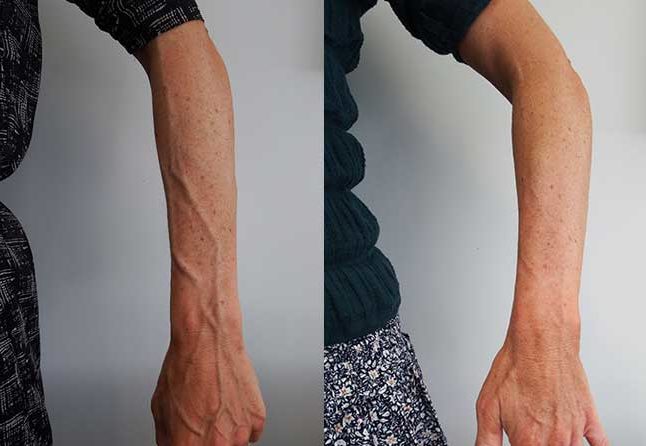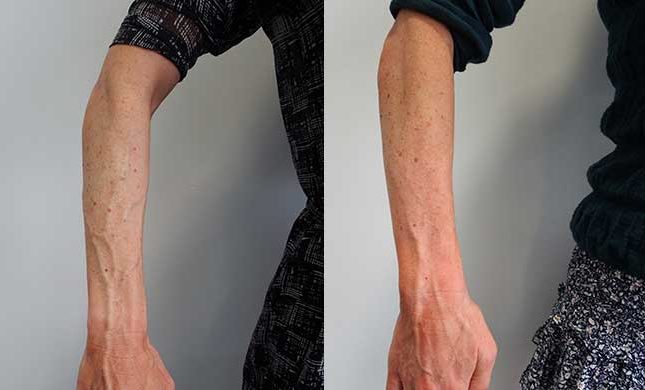Bulging Arm and Hand Veins: Causes and Treatments
Occasionally at Palm Clinic, clients will ask us if there is anything we can do to help with their increasingly prominent hand or arm veins.
Some are concerned that it could be a sign of a medical problem requiring medical advice, others simply don’t like the appearance. The good news is, in the majority of cases, there is no medical concern, but if it is a cosmetic issue for you, we do have a solution.
The cause of bulging hand veins:
- Age: as we age, our skin becomes thinner and loses its forgiving elasticity that usually holds subcutaneous structures in place. These factors can result in bulging of previously less visible hand veins and arm veins.
- Low body fat: while this usually is an indication of good health, it can mean that veins and subcutaneous structures are more visible.
- Genetics: chances are, if your family has prominent hand veins, you could too.
- Exercise: When you exercise your blood pressure increases, delivering increased blood flow to your peripheries (hands and feet). This creates an increased load on the venous drainage system, meaning temporary dilation of your veins. Heavy weight-lifting work can put strain on the valves in your veins causing dilated, visible veins.
- Hot weather: ever noticed how your veins are more visible in the Summer time? When the body heats up, it loses heat to cool down by dilating the veins, bringing the blood closer to the surface of the skin to enhance heat loss. The opposite is seen when the body is cool; the veins contract smaller, delivering less blood to the skin surface to preserve heat.
- Superficial thrombophlebitis: that’s a mouthful! This term essentially describes a blood clot in your superficial veins. It makes the affected segment of vein feel firm, tender and hot and needs medical attention.
- Deep vein thrombosis: this is, as the term indicates, a blood clot in the deep veins of your arm. This also needs medical attention. When the deep veins are obstructed, it severely restricts drainage of the hand and arm. This causes blood to pool in the limb. The signs are a swollen, painful hand, as well as swollen hand veins. These signs tend to persist over time
What are the treatment options for swollen
hand veins?
The first thing for us to determine is whether the cause of your swollen hand veins are something to be concerned about medically, as in numbers 6 and 7 above, or if they are purely of cosmetic concern. In the majority of cases, it is a cosmetic concern.
The treatment options are:
- Dermal filler: we inject dermal filler into the subcutaneous tissue surrounding the veins, to build up the surrounding tissue and disguise the prominent veins (as seen in our before and after pictures). This is a safe and minimally invasive technique that can be done quickly with no down time.
- Sclerotherapy: although we offer this treatment for leg varicose veins, we don’t advocate its use in the arms due to the risk of a deep vein clot in the arm. Sclerotherapy involves injection of a medicine into the veins causing them to close. The body then absorbs the closed vein away. It is used to good effect at Palm Clinic for treating varicose veins in the legs.
- Endovenous ablation therapy: this can be done using laser therapy or radiofrequency ablation therapy. Again, this procedure is offered at Palm Clinic for the treatment of leg varicose veins, but is considered too risky (when there are less-invasive alternatives) for cosmetic treatment of arm or hand veins.
- Ambulatory phlebectomy: this is a surgical procedure that removes the dilated vein using local anaesthetic and sutures.
- Vein stripping and ligation: this is a more involved surgical procedure that involves a general anaesthetic, tying the vein off and cutting it out. We don’t advocate for this treatment for treating arm or hand veins as it is too risky and invasive for what is a cosmetic procedure.
- Treatment of phlebitis: usually we will ensure there is no deep vein involvement of the clot. If the clot is confined to the surface veins, then we would prescribe anti-inflammatory medication, and compression to the hand or arms veins. If the superficial clot is more extensive, we may prescribe anticoagulant (blood thinning medicine) to reduce the chance of a more serious deep vein clot forming.
- Treatment of deep vein arm clot: this will require anticoagulant (blood thinning) medication and a follow-up ultrasound to ensure it is resolving. We would also check for underlying Paget-Schroetter syndrome, which can predispose to deep vein arm clots.





